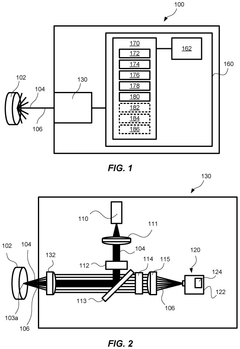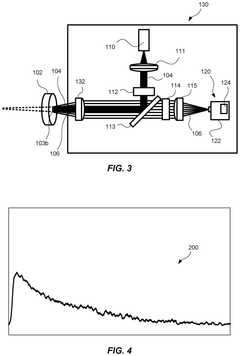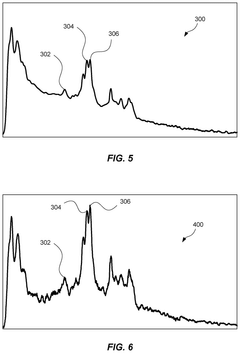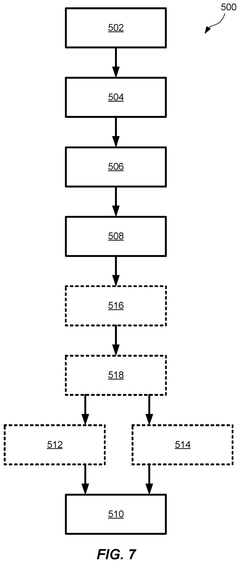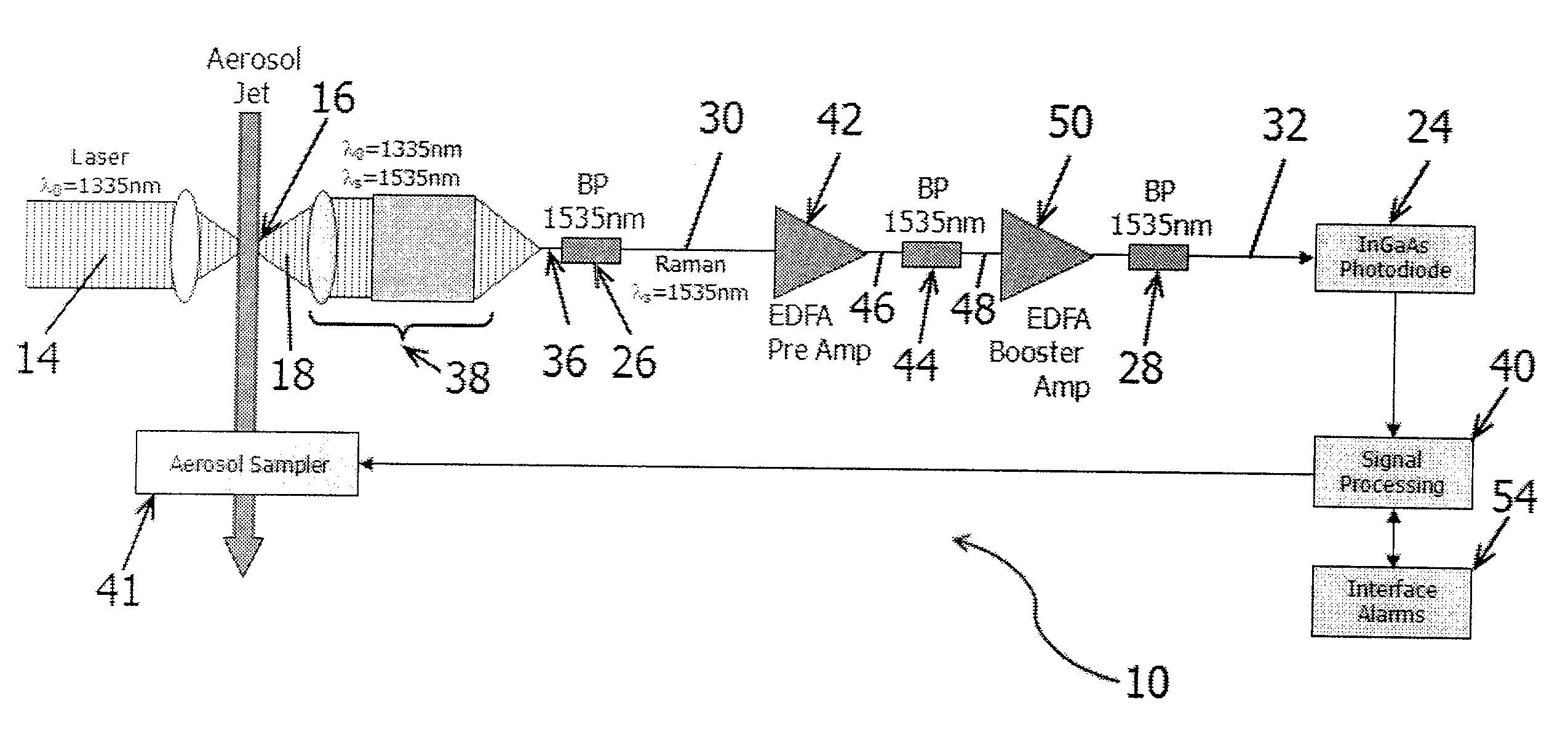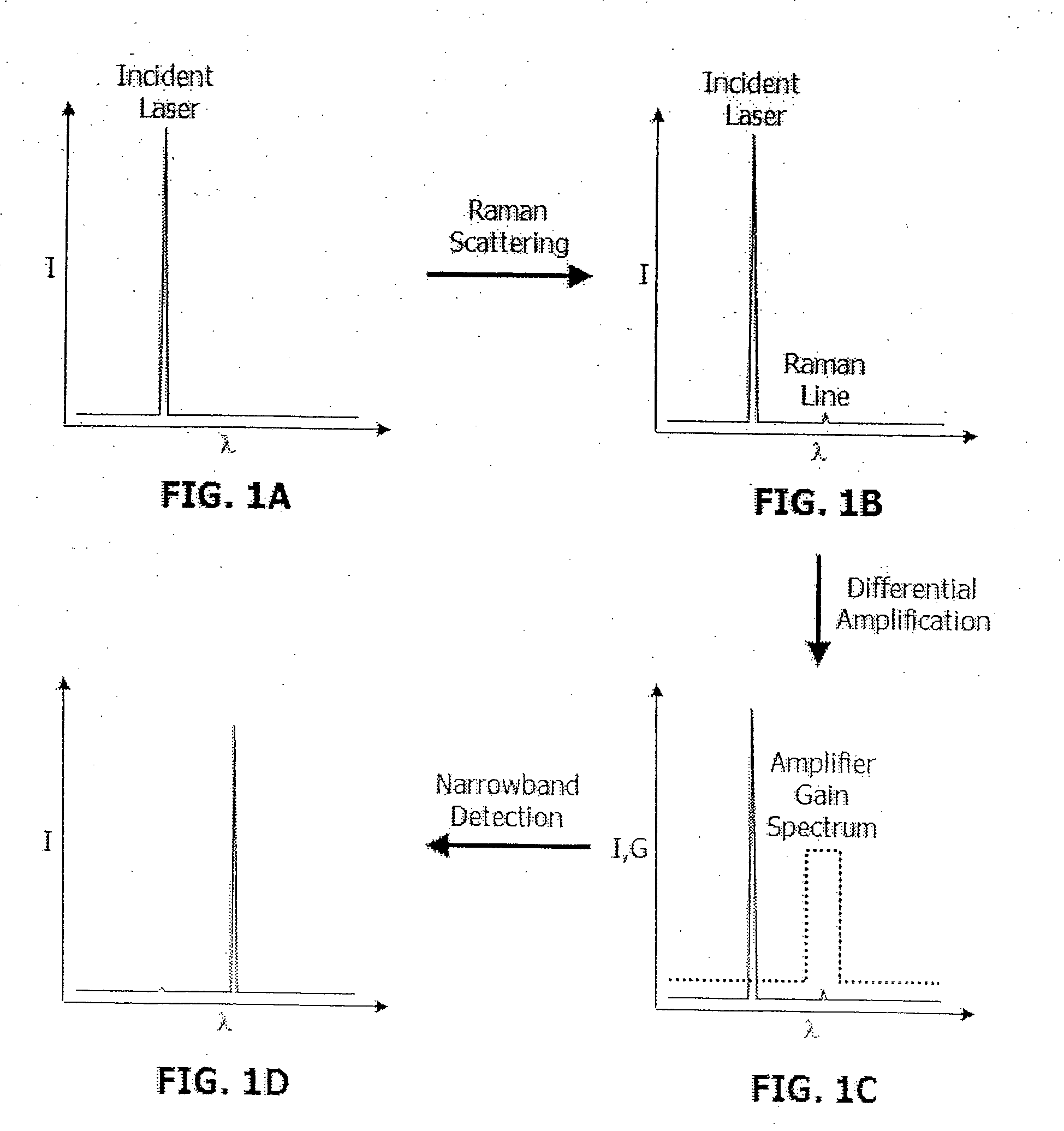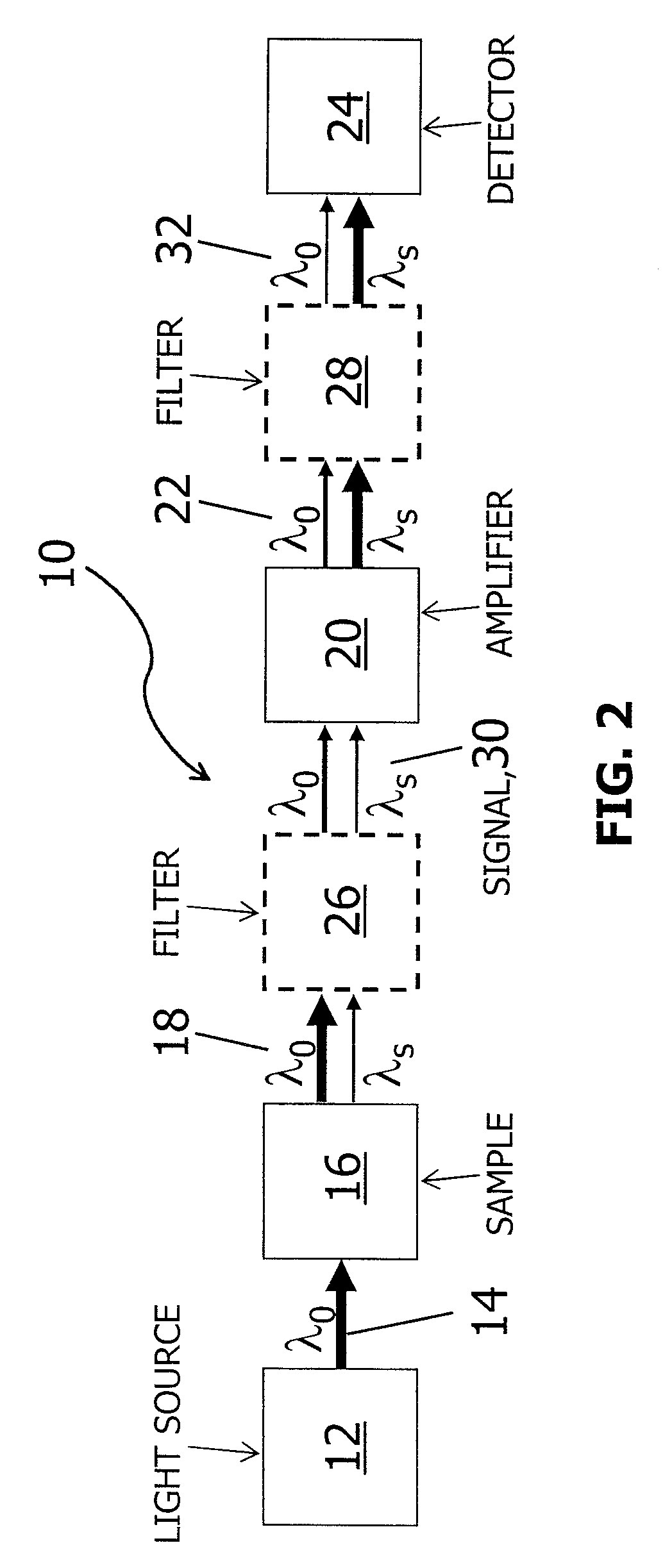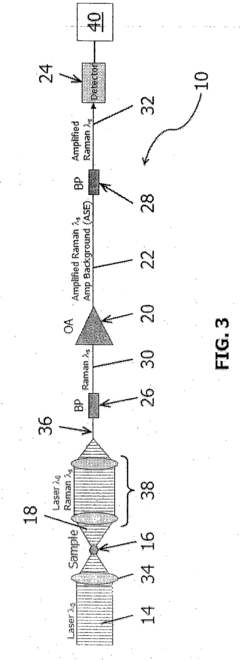Achieving High Raman Spectroscopy Throughput: Strategies
SEP 19, 20259 MIN READ
Generate Your Research Report Instantly with AI Agent
Patsnap Eureka helps you evaluate technical feasibility & market potential.
Raman Spectroscopy Evolution and Throughput Objectives
Raman spectroscopy has evolved significantly since its discovery by C.V. Raman in 1928. Initially limited to basic molecular identification, the technique has undergone remarkable transformation through several key developmental phases. The 1960s marked a pivotal moment with the invention of lasers, which provided the intense monochromatic light sources necessary for efficient Raman scattering detection. This advancement dramatically improved signal quality and expanded the technique's applicability.
The 1970s and 1980s witnessed the integration of computerized data processing systems, enabling more sophisticated spectral analysis and interpretation. By the 1990s, the introduction of charge-coupled device (CCD) detectors revolutionized data collection, allowing for simultaneous measurement across multiple wavelengths and significantly reducing acquisition times from hours to minutes or seconds.
Recent decades have seen the emergence of enhanced Raman techniques such as Surface-Enhanced Raman Spectroscopy (SERS), Tip-Enhanced Raman Spectroscopy (TERS), and Coherent Anti-Stokes Raman Spectroscopy (CARS). These innovations have overcome traditional sensitivity limitations, pushing detection capabilities to the single-molecule level in some applications.
The current technological trajectory points toward miniaturization and increased automation. Portable Raman devices have transitioned from laboratory curiosities to practical field instruments, while AI-assisted spectral interpretation is streamlining analysis workflows. These developments reflect the broader trend toward more accessible, user-friendly systems that maintain analytical power while reducing technical expertise requirements.
Despite these advances, throughput remains a significant challenge in many Raman applications. Current objectives focus on overcoming this limitation through several approaches: increasing laser power without sample damage, developing more sensitive detectors with improved signal-to-noise ratios, and implementing parallel measurement systems for simultaneous multi-sample analysis.
The ultimate goal is to achieve real-time Raman analysis capabilities across diverse sample types and environments. This would enable transformative applications in pharmaceutical manufacturing quality control, environmental monitoring, medical diagnostics, and security screening. Specifically, the industry aims to reduce typical measurement times from minutes to sub-second ranges while maintaining or improving spectral quality and information content.
Emerging research indicates that hybrid approaches combining hardware improvements with advanced computational methods may offer the most promising path forward. Machine learning algorithms for spectral denoising and feature extraction, coupled with optimized optical designs, represent a synergistic approach to throughput enhancement that addresses both physical and data processing bottlenecks simultaneously.
The 1970s and 1980s witnessed the integration of computerized data processing systems, enabling more sophisticated spectral analysis and interpretation. By the 1990s, the introduction of charge-coupled device (CCD) detectors revolutionized data collection, allowing for simultaneous measurement across multiple wavelengths and significantly reducing acquisition times from hours to minutes or seconds.
Recent decades have seen the emergence of enhanced Raman techniques such as Surface-Enhanced Raman Spectroscopy (SERS), Tip-Enhanced Raman Spectroscopy (TERS), and Coherent Anti-Stokes Raman Spectroscopy (CARS). These innovations have overcome traditional sensitivity limitations, pushing detection capabilities to the single-molecule level in some applications.
The current technological trajectory points toward miniaturization and increased automation. Portable Raman devices have transitioned from laboratory curiosities to practical field instruments, while AI-assisted spectral interpretation is streamlining analysis workflows. These developments reflect the broader trend toward more accessible, user-friendly systems that maintain analytical power while reducing technical expertise requirements.
Despite these advances, throughput remains a significant challenge in many Raman applications. Current objectives focus on overcoming this limitation through several approaches: increasing laser power without sample damage, developing more sensitive detectors with improved signal-to-noise ratios, and implementing parallel measurement systems for simultaneous multi-sample analysis.
The ultimate goal is to achieve real-time Raman analysis capabilities across diverse sample types and environments. This would enable transformative applications in pharmaceutical manufacturing quality control, environmental monitoring, medical diagnostics, and security screening. Specifically, the industry aims to reduce typical measurement times from minutes to sub-second ranges while maintaining or improving spectral quality and information content.
Emerging research indicates that hybrid approaches combining hardware improvements with advanced computational methods may offer the most promising path forward. Machine learning algorithms for spectral denoising and feature extraction, coupled with optimized optical designs, represent a synergistic approach to throughput enhancement that addresses both physical and data processing bottlenecks simultaneously.
Market Applications and Demand for High-Throughput Raman Analysis
The global market for Raman spectroscopy has witnessed substantial growth, driven by increasing demand across multiple industries seeking rapid, accurate, and non-destructive analytical capabilities. The market value is projected to reach $3.2 billion by 2027, with high-throughput applications representing a significant growth segment.
Pharmaceutical and biotechnology sectors demonstrate the most robust demand for high-throughput Raman analysis, particularly in drug discovery and development processes. These industries require rapid screening of thousands of compounds, where traditional analytical methods create bottlenecks. High-throughput Raman systems enable real-time monitoring of reactions, crystallization processes, and formulation development, significantly accelerating time-to-market for new therapeutics.
The food and beverage industry represents another major market, where high-throughput Raman analysis facilitates rapid quality control and authentication of raw materials and finished products. With increasing consumer concerns about food safety and authenticity, manufacturers are investing in technologies that can rapidly detect contaminants, verify ingredient composition, and ensure regulatory compliance across high-volume production lines.
Environmental monitoring applications have emerged as a rapidly growing segment, with demand for field-deployable high-throughput Raman systems for water quality analysis, soil contamination assessment, and airborne particulate matter characterization. Government agencies and environmental service companies seek solutions that can process large sample volumes efficiently while maintaining detection sensitivity for trace contaminants.
Industrial manufacturing represents a substantial market opportunity, particularly in semiconductor fabrication, polymer production, and materials science. These sectors require in-line quality control capabilities that can keep pace with high-speed production environments while providing detailed molecular information about products and processes.
Academic and research institutions constitute a significant market segment, driving innovation in high-throughput Raman technologies. The demand for advanced research instrumentation capable of processing large sample sets efficiently continues to grow as scientific studies increasingly involve big data approaches and statistical analysis of large populations.
Geographically, North America and Europe currently dominate the market for high-throughput Raman systems, though Asia-Pacific regions are experiencing the fastest growth rate, particularly in China, Japan, and South Korea. This growth is fueled by expanding pharmaceutical manufacturing, increasing industrial automation, and substantial government investments in analytical technologies.
Market analysis indicates that customers across all sectors prioritize three key factors when adopting high-throughput Raman solutions: increased sample processing speed, improved data quality/reliability, and enhanced automation capabilities that reduce operator intervention requirements.
Pharmaceutical and biotechnology sectors demonstrate the most robust demand for high-throughput Raman analysis, particularly in drug discovery and development processes. These industries require rapid screening of thousands of compounds, where traditional analytical methods create bottlenecks. High-throughput Raman systems enable real-time monitoring of reactions, crystallization processes, and formulation development, significantly accelerating time-to-market for new therapeutics.
The food and beverage industry represents another major market, where high-throughput Raman analysis facilitates rapid quality control and authentication of raw materials and finished products. With increasing consumer concerns about food safety and authenticity, manufacturers are investing in technologies that can rapidly detect contaminants, verify ingredient composition, and ensure regulatory compliance across high-volume production lines.
Environmental monitoring applications have emerged as a rapidly growing segment, with demand for field-deployable high-throughput Raman systems for water quality analysis, soil contamination assessment, and airborne particulate matter characterization. Government agencies and environmental service companies seek solutions that can process large sample volumes efficiently while maintaining detection sensitivity for trace contaminants.
Industrial manufacturing represents a substantial market opportunity, particularly in semiconductor fabrication, polymer production, and materials science. These sectors require in-line quality control capabilities that can keep pace with high-speed production environments while providing detailed molecular information about products and processes.
Academic and research institutions constitute a significant market segment, driving innovation in high-throughput Raman technologies. The demand for advanced research instrumentation capable of processing large sample sets efficiently continues to grow as scientific studies increasingly involve big data approaches and statistical analysis of large populations.
Geographically, North America and Europe currently dominate the market for high-throughput Raman systems, though Asia-Pacific regions are experiencing the fastest growth rate, particularly in China, Japan, and South Korea. This growth is fueled by expanding pharmaceutical manufacturing, increasing industrial automation, and substantial government investments in analytical technologies.
Market analysis indicates that customers across all sectors prioritize three key factors when adopting high-throughput Raman solutions: increased sample processing speed, improved data quality/reliability, and enhanced automation capabilities that reduce operator intervention requirements.
Current Limitations and Technical Challenges in Raman Throughput
Despite significant advancements in Raman spectroscopy technology, several critical limitations continue to impede the achievement of optimal throughput in both research and industrial applications. The fundamental challenge stems from the inherently weak nature of the Raman effect itself, with typical scattering efficiencies of approximately 10^-6 to 10^-8 of the incident light. This physical constraint necessitates longer acquisition times, particularly for samples with low concentrations or weak Raman signatures.
Instrumentation limitations represent another significant barrier to high throughput. Traditional spectrometers often face a trade-off between spectral resolution and light throughput. High-resolution measurements typically require narrow slit widths and longer focal length spectrographs, which reduce the amount of light reaching the detector. Additionally, conventional gratings exhibit efficiency limitations across broad spectral ranges, creating bottlenecks in the optical pathway.
Detector technology presents further challenges. While CCD detectors have been the standard for many years, they suffer from readout noise and limited quantum efficiency in certain spectral regions. Even modern CMOS and sCMOS detectors, despite improvements, still face sensitivity limitations when dealing with the weak signals characteristic of Raman scattering.
Sample-related issues compound these technical challenges. Fluorescence interference remains one of the most persistent problems in Raman spectroscopy, often overwhelming the weaker Raman signals. This is particularly problematic for biological samples and materials with natural fluorophores. Additionally, sample heterogeneity can necessitate multiple measurements at different locations, significantly reducing throughput in mapping applications.
Data processing bottlenecks further constrain throughput capabilities. The large datasets generated during Raman mapping or time-series experiments require substantial computational resources for processing and analysis. Current algorithms for baseline correction, cosmic ray removal, and multivariate analysis can be time-consuming, especially when processing thousands of spectra simultaneously.
Automation limitations also impact throughput efficiency. Many Raman systems still require significant manual intervention for sample preparation, positioning, and measurement parameter optimization. The lack of standardized protocols for automated sample handling and measurement across diverse sample types restricts the development of truly high-throughput systems.
Lastly, there exists a fundamental engineering challenge in balancing measurement speed with data quality. Attempts to increase throughput by reducing acquisition time or increasing laser power often result in compromised spectral quality or potential sample damage, particularly for sensitive biological or pharmaceutical materials. This creates a complex optimization problem that varies significantly across different application domains.
Instrumentation limitations represent another significant barrier to high throughput. Traditional spectrometers often face a trade-off between spectral resolution and light throughput. High-resolution measurements typically require narrow slit widths and longer focal length spectrographs, which reduce the amount of light reaching the detector. Additionally, conventional gratings exhibit efficiency limitations across broad spectral ranges, creating bottlenecks in the optical pathway.
Detector technology presents further challenges. While CCD detectors have been the standard for many years, they suffer from readout noise and limited quantum efficiency in certain spectral regions. Even modern CMOS and sCMOS detectors, despite improvements, still face sensitivity limitations when dealing with the weak signals characteristic of Raman scattering.
Sample-related issues compound these technical challenges. Fluorescence interference remains one of the most persistent problems in Raman spectroscopy, often overwhelming the weaker Raman signals. This is particularly problematic for biological samples and materials with natural fluorophores. Additionally, sample heterogeneity can necessitate multiple measurements at different locations, significantly reducing throughput in mapping applications.
Data processing bottlenecks further constrain throughput capabilities. The large datasets generated during Raman mapping or time-series experiments require substantial computational resources for processing and analysis. Current algorithms for baseline correction, cosmic ray removal, and multivariate analysis can be time-consuming, especially when processing thousands of spectra simultaneously.
Automation limitations also impact throughput efficiency. Many Raman systems still require significant manual intervention for sample preparation, positioning, and measurement parameter optimization. The lack of standardized protocols for automated sample handling and measurement across diverse sample types restricts the development of truly high-throughput systems.
Lastly, there exists a fundamental engineering challenge in balancing measurement speed with data quality. Attempts to increase throughput by reducing acquisition time or increasing laser power often result in compromised spectral quality or potential sample damage, particularly for sensitive biological or pharmaceutical materials. This creates a complex optimization problem that varies significantly across different application domains.
State-of-the-Art High-Throughput Raman Methodologies
01 High-throughput Raman spectroscopy systems
Advanced Raman spectroscopy systems designed for high-throughput analysis incorporate optimized optical components, automated sample handling, and parallel processing capabilities. These systems enable rapid analysis of multiple samples, reducing measurement time while maintaining spectral quality. Key innovations include multi-channel detectors, automated stage positioning, and specialized algorithms for faster data acquisition and processing.- High-throughput Raman spectroscopy systems: Advanced systems designed to increase the throughput of Raman spectroscopy measurements through optimized optical configurations, parallel processing capabilities, and automated sample handling. These systems enable rapid analysis of multiple samples or large sample areas, significantly reducing measurement time while maintaining spectral quality. Key innovations include multi-channel detectors, spatial multiplexing techniques, and integrated sample positioning systems that allow for continuous scanning.
- Enhanced signal processing for Raman throughput improvement: Signal processing techniques and algorithms that enhance the throughput of Raman spectroscopy by improving signal-to-noise ratios, reducing acquisition times, and enabling real-time data analysis. These approaches include advanced filtering methods, chemometric analysis, machine learning algorithms for spectral interpretation, and specialized software solutions that optimize data collection parameters based on sample characteristics. The implementation of these processing techniques allows for faster analysis without compromising measurement accuracy.
- Miniaturized and portable Raman systems for high-throughput applications: Compact and portable Raman spectroscopy systems designed for high-throughput field applications or point-of-use testing. These systems incorporate miniaturized optical components, integrated lasers, and efficient detectors to maintain high throughput capabilities while reducing size and power requirements. The miniaturization enables deployment in various environments including industrial production lines, medical facilities, and field research, where rapid sample analysis is critical.
- Multimodal spectroscopy integration for enhanced throughput: Integration of Raman spectroscopy with complementary analytical techniques to enhance overall throughput and analytical capabilities. These systems combine Raman with other spectroscopic methods such as infrared, fluorescence, or mass spectrometry to provide comprehensive sample characterization in a single measurement process. The multimodal approach reduces the need for separate analyses, increases information content per measurement, and improves sample throughput by collecting multiple data types simultaneously.
- Novel optical configurations for Raman throughput optimization: Innovative optical designs and configurations specifically developed to optimize the throughput of Raman spectroscopy systems. These include specialized collection optics, beam shaping elements, novel spectrometer designs, and advanced filtering technologies that maximize light collection efficiency and spectral resolution. The optical innovations enable faster acquisition times, improved spatial resolution, and enhanced sensitivity, allowing for higher sample throughput without sacrificing data quality.
02 Enhanced signal processing techniques
Signal processing innovations significantly improve Raman spectroscopy throughput by optimizing data handling and analysis. These techniques include advanced algorithms for noise reduction, baseline correction, and spectral deconvolution that enable faster processing of complex spectral data. Real-time data processing methods and machine learning approaches further enhance throughput by reducing analysis time and improving spectral interpretation efficiency.Expand Specific Solutions03 Optical design improvements for throughput enhancement
Innovative optical designs significantly improve Raman spectroscopy throughput by optimizing light collection efficiency and signal transmission. These include specialized lens arrangements, fiber optic configurations, and beam shaping technologies that maximize the collection of scattered Raman signals. Advanced spectrometer designs with optimized gratings and optical paths reduce signal losses and increase overall system efficiency.Expand Specific Solutions04 Integration with automated sample handling
Integration of Raman spectroscopy with automated sample handling systems dramatically increases throughput capabilities. These systems incorporate robotic sample positioning, microfluidic platforms, and automated sample preparation techniques to enable continuous analysis of multiple samples. Specialized sample holders and arrays allow for batch processing, while synchronized control systems ensure optimal coordination between sample presentation and spectral acquisition.Expand Specific Solutions05 Miniaturized and portable Raman systems
Miniaturized and portable Raman spectroscopy systems offer improved throughput in field and point-of-use applications. These compact designs incorporate integrated components, simplified optics, and efficient power management to enable rapid analysis outside laboratory settings. Advancements in miniaturized lasers, detectors, and spectrometers maintain analytical performance while reducing size and complexity, allowing for higher throughput in diverse operational environments.Expand Specific Solutions
Leading Companies and Research Institutions in Raman Technology
The Raman spectroscopy throughput market is currently in a growth phase, with increasing adoption across pharmaceutical, biomedical, and industrial applications. The global market size is estimated to exceed $2 billion, driven by demand for faster, more efficient analytical techniques. Technology maturity varies across implementation approaches, with companies like Horiba Ltd. and ChemImage Corp. leading in commercial instrumentation development, while academic institutions such as Tianjin University and East China Normal University focus on fundamental research advancements. Emerging players like Nanophoton Corp. and CytoVeris are introducing innovative solutions for specialized applications, particularly in medical diagnostics. The competitive landscape shows a blend of established analytical instrument manufacturers and specialized startups developing proprietary high-throughput technologies, with increasing collaboration between industry and academic research centers.
ChemImage Corp.
Technical Solution: ChemImage has developed innovative Raman chemical imaging technology that combines spectral and spatial information for high-throughput analysis. Their systems utilize wide-field Raman imaging approaches that capture spectral data from large sample areas simultaneously, dramatically increasing sample throughput compared to traditional point-by-point mapping. ChemImage's technology incorporates liquid crystal tunable filters (LCTF) and advanced detector arrays that enable rapid wavelength scanning while maintaining high spectral resolution[5]. Their systems feature proprietary chemometric algorithms that perform real-time data processing and classification, reducing analysis time for complex samples. ChemImage has also developed specialized sample illumination strategies that optimize signal generation while minimizing photodegradation, allowing for faster acquisition times without compromising sample integrity. Additionally, their technology incorporates automated focusing and calibration routines that reduce setup time between measurements[6].
Strengths: Exceptional spatial-spectral data acquisition capabilities; advanced chemometric analysis tools integrated into hardware; ability to analyze heterogeneous samples efficiently. Weaknesses: Higher complexity in data interpretation; specialized applications may require customized solutions; initial system cost can be substantial.
Horiba Ltd.
Technical Solution: Horiba has developed advanced Raman spectroscopy systems featuring their LabRAM HR Evolution platform, which incorporates ultrafast confocal imaging capabilities and automated XYZ mapping. Their technology utilizes multi-channel detectors and proprietary SWIFT™ technology that enables rapid spectral acquisition with speeds up to 1000 spectra per second[1]. The system integrates specialized optical designs with high-throughput spectrographs and optimized collection optics to maximize signal collection efficiency. Horiba's approach also includes advanced software algorithms for real-time data processing and analysis, reducing the time required for post-acquisition analysis. Their systems feature automated laser switching and alignment capabilities, minimizing downtime between measurements and enabling continuous operation for high-volume sample processing[2]. Additionally, Horiba has implemented parallel measurement techniques that allow simultaneous acquisition from multiple sample points.
Strengths: Industry-leading acquisition speeds with proprietary SWIFT™ technology; comprehensive integration of hardware and software solutions; excellent signal-to-noise ratio even at high acquisition rates. Weaknesses: Higher cost compared to simpler systems; complex operation requiring specialized training; some configurations may have limitations in specific application environments.
Breakthrough Technologies for Raman Signal Enhancement
Method for enhancing a raman contribution in a spectrum, spectroscopy system, computer program and non-transitory computer-readable storage medium
PatentPendingUS20250093269A1
Innovation
- The method involves setting a first and second spot size of light emitted by a light source at a sample, recording spectra with each spot size, and forming a data set based on the dissimilarity between the spectra to enhance the Raman contribution, using a liquid lens to adjust the focal point and intensity, thereby improving the signal-to-noise ratio and suppressing fluorescence and other optical responses.
Raman spectrometer having wavelength-selective optical amplification
PatentInactiveUS20100079753A1
Innovation
- A Raman spectrometer utilizing wavelength-selective optical amplification to enhance the detection sensitivity by selectively amplifying Raman scattering photons over incident laser photons, allowing for low-power operation and compact design.
Integration with AI and Machine Learning for Faster Analysis
The integration of artificial intelligence and machine learning technologies with Raman spectroscopy represents a transformative approach to addressing throughput limitations. These computational methods can significantly reduce analysis time while maintaining or even improving accuracy, thereby enhancing overall system efficiency.
Machine learning algorithms, particularly deep learning neural networks, have demonstrated remarkable capabilities in spectral data processing. By training these systems on large datasets of Raman spectra, they can rapidly identify patterns and correlations that would require extensive time for human analysts to detect. This automated pattern recognition enables real-time classification of samples, dramatically reducing the time from measurement to result interpretation.
Convolutional Neural Networks (CNNs) have proven particularly effective for Raman spectral analysis. These networks can be trained to automatically extract relevant features from spectral data, eliminating the need for manual preprocessing steps such as baseline correction and peak identification. Studies have shown that CNN-based approaches can reduce analysis time by up to 80% compared to traditional methods while maintaining comparable accuracy levels.
Transfer learning techniques further enhance this integration by allowing pre-trained models to be adapted for specific Raman applications with minimal additional training data. This approach is especially valuable in industrial settings where developing large custom datasets may be impractical but rapid implementation is essential.
Automated decision-making systems powered by AI can also optimize measurement parameters in real-time. By continuously analyzing incoming spectral data, these systems can adjust laser power, integration time, and sampling strategies to maximize signal quality while minimizing acquisition time. This adaptive approach ensures optimal throughput without sacrificing data quality.
Cloud-based processing architectures complement these AI methods by providing scalable computational resources. By offloading intensive calculations to cloud servers, even portable Raman systems can leverage sophisticated AI algorithms without requiring powerful onboard processors. This distributed computing model enables high-throughput analysis even with compact instrumentation.
Recent developments in explainable AI (XAI) are addressing transparency concerns in clinical and regulatory environments. These techniques provide insights into how AI systems reach their conclusions, building trust in automated analysis results and facilitating regulatory approval for AI-enhanced Raman systems in sensitive applications like medical diagnostics and pharmaceutical quality control.
Machine learning algorithms, particularly deep learning neural networks, have demonstrated remarkable capabilities in spectral data processing. By training these systems on large datasets of Raman spectra, they can rapidly identify patterns and correlations that would require extensive time for human analysts to detect. This automated pattern recognition enables real-time classification of samples, dramatically reducing the time from measurement to result interpretation.
Convolutional Neural Networks (CNNs) have proven particularly effective for Raman spectral analysis. These networks can be trained to automatically extract relevant features from spectral data, eliminating the need for manual preprocessing steps such as baseline correction and peak identification. Studies have shown that CNN-based approaches can reduce analysis time by up to 80% compared to traditional methods while maintaining comparable accuracy levels.
Transfer learning techniques further enhance this integration by allowing pre-trained models to be adapted for specific Raman applications with minimal additional training data. This approach is especially valuable in industrial settings where developing large custom datasets may be impractical but rapid implementation is essential.
Automated decision-making systems powered by AI can also optimize measurement parameters in real-time. By continuously analyzing incoming spectral data, these systems can adjust laser power, integration time, and sampling strategies to maximize signal quality while minimizing acquisition time. This adaptive approach ensures optimal throughput without sacrificing data quality.
Cloud-based processing architectures complement these AI methods by providing scalable computational resources. By offloading intensive calculations to cloud servers, even portable Raman systems can leverage sophisticated AI algorithms without requiring powerful onboard processors. This distributed computing model enables high-throughput analysis even with compact instrumentation.
Recent developments in explainable AI (XAI) are addressing transparency concerns in clinical and regulatory environments. These techniques provide insights into how AI systems reach their conclusions, building trust in automated analysis results and facilitating regulatory approval for AI-enhanced Raman systems in sensitive applications like medical diagnostics and pharmaceutical quality control.
Miniaturization and Portability Trends for Field Applications
The miniaturization and portability of Raman spectroscopy systems represent a significant trend in addressing throughput challenges, particularly for field applications where laboratory-grade equipment is impractical. Recent advancements in component miniaturization have led to the development of handheld Raman devices weighing less than 1 kg, compared to traditional benchtop systems exceeding 20 kg. This dramatic reduction in size and weight has been achieved through innovations in laser sources, detector technologies, and optical components.
Semiconductor laser diodes have replaced bulky gas lasers, offering comparable performance while consuming significantly less power—typically under 5W compared to 50-100W for traditional systems. These compact lasers maintain spectral stability while enabling battery operation, a critical requirement for field deployment. Similarly, the evolution from photomultiplier tubes to compact CCD and CMOS detectors has reduced both size and power requirements while improving sensitivity.
Optical miniaturization has progressed through the integration of photonic circuits and MEMS (Micro-Electro-Mechanical Systems) technologies. Waveguide-based spectrometers on silicon chips now replace conventional diffraction gratings and lenses, reducing optical path lengths from centimeters to micrometers while maintaining resolution. Companies like Ocean Insight and Hamamatsu have pioneered miniature spectrometers smaller than a smartphone while achieving sub-10 cm⁻¹ resolution.
Battery technology improvements have extended field operation times from 2-3 hours to full working days (8+ hours) on a single charge. Modern portable Raman systems incorporate lithium polymer batteries with energy densities exceeding 250 Wh/kg, supporting continuous operation without compromising analytical performance.
Data processing capabilities have also evolved significantly, with embedded processors now performing complex algorithms previously requiring desktop computers. Field-portable devices incorporate specialized ASICs and FPGAs that execute spectral processing with minimal power consumption, enabling real-time analysis and reducing the need for post-collection processing.
These miniaturization efforts have expanded Raman spectroscopy into previously inaccessible applications, including environmental monitoring, food safety testing, pharmaceutical verification, and geological field analysis. The convergence of miniaturization with cloud connectivity has further enhanced throughput by enabling remote data analysis and interpretation, effectively distributing the computational workload beyond the physical device.
As miniaturization continues, we anticipate further integration with complementary technologies such as AI-powered spectral interpretation and multi-modal sensing platforms that combine Raman with other spectroscopic techniques, ultimately transforming field analysis capabilities while maintaining high throughput performance.
Semiconductor laser diodes have replaced bulky gas lasers, offering comparable performance while consuming significantly less power—typically under 5W compared to 50-100W for traditional systems. These compact lasers maintain spectral stability while enabling battery operation, a critical requirement for field deployment. Similarly, the evolution from photomultiplier tubes to compact CCD and CMOS detectors has reduced both size and power requirements while improving sensitivity.
Optical miniaturization has progressed through the integration of photonic circuits and MEMS (Micro-Electro-Mechanical Systems) technologies. Waveguide-based spectrometers on silicon chips now replace conventional diffraction gratings and lenses, reducing optical path lengths from centimeters to micrometers while maintaining resolution. Companies like Ocean Insight and Hamamatsu have pioneered miniature spectrometers smaller than a smartphone while achieving sub-10 cm⁻¹ resolution.
Battery technology improvements have extended field operation times from 2-3 hours to full working days (8+ hours) on a single charge. Modern portable Raman systems incorporate lithium polymer batteries with energy densities exceeding 250 Wh/kg, supporting continuous operation without compromising analytical performance.
Data processing capabilities have also evolved significantly, with embedded processors now performing complex algorithms previously requiring desktop computers. Field-portable devices incorporate specialized ASICs and FPGAs that execute spectral processing with minimal power consumption, enabling real-time analysis and reducing the need for post-collection processing.
These miniaturization efforts have expanded Raman spectroscopy into previously inaccessible applications, including environmental monitoring, food safety testing, pharmaceutical verification, and geological field analysis. The convergence of miniaturization with cloud connectivity has further enhanced throughput by enabling remote data analysis and interpretation, effectively distributing the computational workload beyond the physical device.
As miniaturization continues, we anticipate further integration with complementary technologies such as AI-powered spectral interpretation and multi-modal sensing platforms that combine Raman with other spectroscopic techniques, ultimately transforming field analysis capabilities while maintaining high throughput performance.
Unlock deeper insights with Patsnap Eureka Quick Research — get a full tech report to explore trends and direct your research. Try now!
Generate Your Research Report Instantly with AI Agent
Supercharge your innovation with Patsnap Eureka AI Agent Platform!
